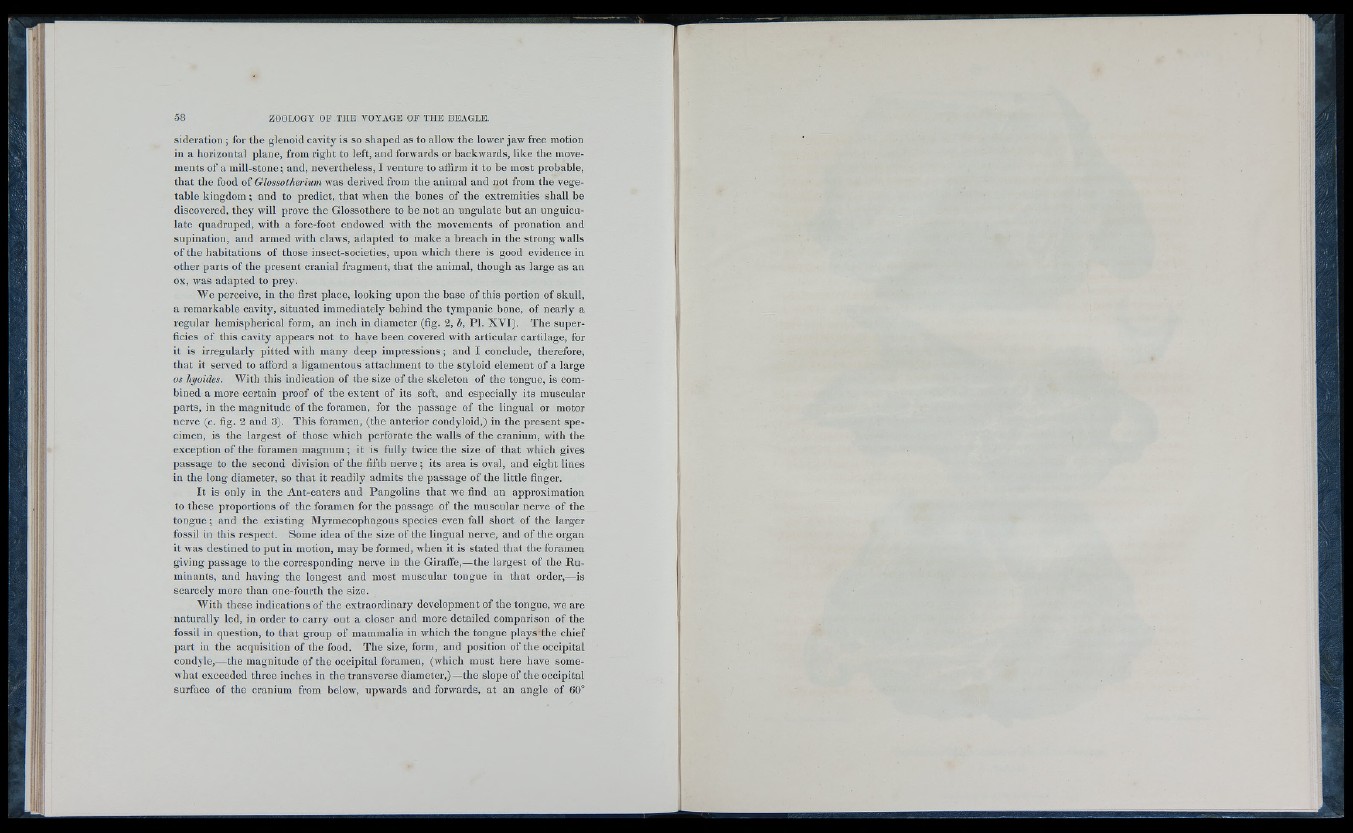
sidération ; for the glenoid cavity is so shaped as to allow the lower jaw free motion
in a horizontal plane, from right to left, and forwards or backwards, like the movements
o f a mill-stone; and, nevertheless, I venture to affirm it to be most probable,
that the food of Glossotherium was derived from the animal and not from the v eg e table
kingdom ; and to predict, that when the bones o f the extremities shall be
discovered, they will prove the Glossothere to be not an ungulate but an unguiculate
quadruped, with a fore-foot endowed with the movements o f pronation and
supination, and armed with claws, adapted to make a breach in the strong walls
o f the habitations o f those insect-societies, upon which there is good evidence in
other parts of the present cranial fragment, that the animal, though as large as an
ox, was adapted to prey.
W e perceive, in the first place, looking upon the base o f this portion o f skull,
a remarkable cavity, situated immediately behind the tympanic bone, o f nearly a
regular hemispherical form, an inch in diameter (fig. 2 , b, PI. X V I ). Th e superficies
o f this cavity appears not to have been covered with articular cartilage, for
it is irregularly pitted with many deep impressions ; and I conclude, therefore,
that it served to afford a ligamentous attachment to the styloid element of a large
os hyoides. With this indication o f the size o f the skeleton o f the tongue, is combined
a more certain proof o f the ex tent o f its soft, and especially its muscular
parts, in the magnitude o f the foramen, for the passage o f the lingual or motor
nerve (c. fig. 2 and 3). This foramen, (the anterior condyloid,) in the present specimen,
is the largest o f those which perforate the walls o f the cranium, with the
exception o f the foramen magnum ; it is fully twice the size o f that which gives
passage to the second division o f the fifth nerve ; its area is oval, and eight lines
in the long diameter, so that it readily admits the pa ssa g e o f the little finger.
I t is only in the Ant-eaters and Pangolins that we find an approximation
to these proportions o f the foramen for the passage o f the muscular nerve o f the
tongue ; and the ex isting Myrmecophagous species even fall short o f the larger
fossil in this respect. Some idea o f the size of the lingual nerve, and o f the organ
it was destined to put in motion, may be formed, when it is stated that the foramen
giving passage to the corresponding nerve in the Giraffe,—the largest o f the Ru minants,
and having the long est and most muscular tongue in that order,—is
scarcely more than one-fourth the size.
With these indications o f the extraordinary development o f the tongue, we are
naturally led, in order to carry out a closer and more detailed comparison o f the
fossil in question, to that group o f mammalia in which the tongue plays the chief
part in the acquisition o f the food. The size, form, and position o f the occipital
condyle,—the magnitude o f the occipital foramen, (which must here have somewhat
exceeded three inches in the transverse diameter,)—the slope o f the occipital
surface o f the cranium from below, upwards and forwards, at an angle o f 00°